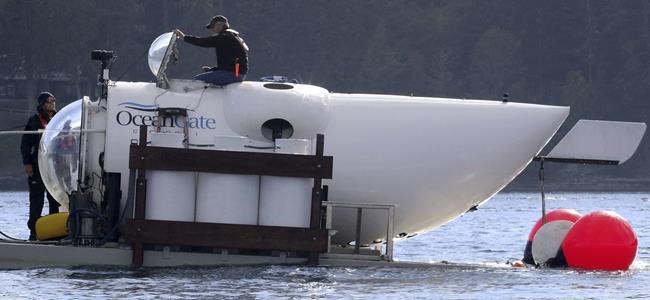
OceanGate CEO Stockton Rush emerges from the hatch atop the OceanGate submarine Cyclops 1 in the San Juan Islands, Wash., on Sept. 12, 2018. Rescuers in a remote area of the Atlantic Ocean raced against time Tuesday to find a missing submersible before the oxygen supply runs out for five people, including Stockton, who were on a mission to document the wreckage of the Titanic. (Alan Berner/The Seattle Times via AP)
June 20, 2023 - 3:26 PM
As crews raced to locate a submersible vessel that vanished Sunday during a descent to the wreckage of the Titanic, explorers who have completed the journey recalled that during their voyages, they took comfort in safety protocols and the laws of physics.
Don Lynch, the official historian for the Titanic Historical Society, visited the shipwreck twice in 2001 aboard Russian submersibles Mir-1 and Mir-2 for the filming of the James Cameron-directed documentary “Ghosts of the Abyss.” In an interview from California, Lynch said it was knowledge of the crushing pressure from the nearly 3.8 kilometres of water above the decaying ship that brought an odd sense of peace.
"When I went down, the most comforting thing to know was that if there was ever a leak in the submersible, it would implode instantly and there would be no suffering," he said. "And that's quite comforting."
Officials overseeing the search about 700 kilometres south of St. John’s, N.L., confirmed Tuesday afternoon that the five people aboard the 6.7-metre-long Titan submersible had about 40 hours of oxygen left. The Titan is owned and operated by OceanGate Expeditions, and the company's chief executive officer, Stockton Rush, is among the passengers.
Lynch said that when he made the descent aboard the Russian-owned Mir submersibles, the practice was always to send two vessels down at once. That way, one could help if the other ran into trouble.
The descent took about two hours, he said. The submarine would be shut down to minimum power for the journey down, and then the pilot would power it up about 15 minutes before it reached the sea floor.
The Titan is said to have lost contact with its launch ship about an hour and 45 minutes after it began its descent. Lynch said though he's not familiar with its protocols, he wonders if the submersible also powered down for the descent and then was unable to power up when it got close to its destination.
Lynch said that on his voyage he asked what would happen if someone panicked due to claustrophobia and was told, very seriously, “the Russians keep a really big wrench in the submersible .... If somebody suddenly goes nuts, what do you do? All you can do is just knock them out.”
Toronto-based physician and undersea explorer Joe MacInnis recalled Tuesday a close call he had at the Titanic site in 1991 when the pilot of the Mir submersible he was in got one of the landing skids stuck under some wire on the ocean floor.
“It was the longest 30 minutes of my life," MacInnis said in an interview. "It was what we call a thick adrenalin moment."
What helped save him was having a second submersible nearby that came in to assess the situation. "The two sub pilots talked back and forth. And the second pilot helped our pilot get free of the tangle of wire — moving backwards, moving forwards .... We had this kind of self-rescue capability which made the difference, really made the difference," he said.
Newfoundland-based Titanic expedition expert Larry Daley said weather conditions this time of year are optimal for crews to be diving to the wreck to find the Titan. And Newfoundland, he said, is home to — or close to — many powerful rescue craft that can assist with the search.
He went down to the Titanic on June 25, 2003, aboard the Mir-1. He said the roughly eight-metre-long Mir submersibles, which have since been decommissioned, were very robust. "I think, generally, submersible diving is very safe. It's been on the go for over 50 years," he said.
Daley said it was cramped inside but it helped to know another submersible was nearby if something went wrong. "It felt comfortable, it felt safe," he said. "Knowing that there was another sub down there with us at the time was good, because the second sub dropped down about a half-hour after we did."
He said he didn't get any sleep Monday night, as he worried about the people inside the Titan. "Obviously it's very sad to think about being trapped in a submersible at that depth," he said.
MacInnis said there is fraternity among those who have dived to such depths.
“I’ve had a long, complex relationship with what I call the Mount Everest of shipwrecks. And so this really hit me," he said. "The ocean community, those people who know the ocean and who've gone to 4,000 metres and deeper, they're really hit hard by this."
This report by The Canadian Press was first published June 20, 2023
— With files from Cassandra Szklarski in Toronto.
News from © The Canadian Press, 2023